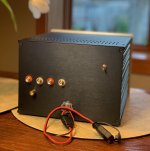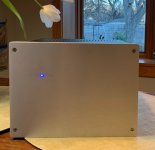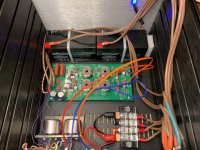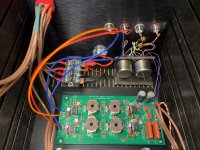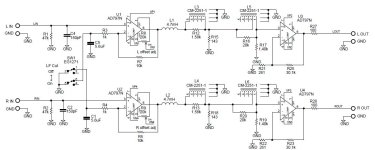Finished this a few weeks ago and finally got around to taking photos. I went with SLA batteries. MC only, wiring the Cinemag step up transformers directly to the jacks and board. Really enjoying the sound of it! Very quiet. The batteries last way longer than I can listen, even giving it a couple hours to warm up, and they charge quickly. Now that I’m confident in the battery solution, I’ll probably swap the power supply wiring with something better than lamp cord. A rotary switch or pins for R1 & R2 to vary the loading would also be a good addition. Very happy with it for now!
Attachments
I'd have picked a battery chemistry with a low self-discharge rate, lead-acid need charging every month or so to prevent sulfation, why not pick LiFePO4 or hybrid NiMH?
The charger is external. This one https://www.amazon.com/gp/product/B07W46BX31/ I just unscrewed the clamps. The 4PDT switch on the back switches the batteries between the charger and the phono pre so the charger is disconnected when the pre is powered on. The charger charges the batteries when the pre is switched off and keeps them trickle charged.
I went with SLA for simplicity, cost and familiarity.
I went with SLA for simplicity, cost and familiarity.
But not weight? Worth considering LiFePO4 batteries as these have allegedly 2000+ charge cycles so should endure a long time, and are less heavy(!)I went with SLA for simplicity, cost and familiarity.
My experience with LA is I always trash them through neglect unless used in a vehicle. My experience with LiFePO4 is they just work (always use a BMS).
What is the advantage of using inductors in phono EQ compared to using capacitors? Only disadvantage that I could see is that inductors could be more sensitive to hum pickup from magnetic hum sources such as power transformers.
In this case there is no power transformer!
But often times capacitors are labelled as bad actors and have undesirable sonic properties when in the signal path.
There appear to be no capacitors at all in the signal path of the Millett preamp.
It's just another way to accomplish the same goal. And a rather interesting one, at that.
But often times capacitors are labelled as bad actors and have undesirable sonic properties when in the signal path.
There appear to be no capacitors at all in the signal path of the Millett preamp.
It's just another way to accomplish the same goal. And a rather interesting one, at that.
Attachments
I did some tests with LR and LCR networks. For this purpose I made a phono preamp where the riaa filter was pluggable, in order to switch between RC, RCL or LR.What is the advantage of using inductors in phono EQ compared to using capacitors? Only disadvantage that I could see is that inductors could be more sensitive to hum pickup from magnetic hum sources such as power transformers.
LR and LCR always sounded better and had less noise than RC. However, they also had a (much) lower impedance than the RC networks tested
I suppose resistor generated noise would be lower in the LC designs.I did some tests with LR and LCR networks. For this purpose I made a phono preamp where the riaa filter was pluggable, in order to switch between RC, RCL or LR.
LR and LCR always sounded better and had less noise than RC. However, they also had a (much) lower impedance than the RC networks tested
My experience with this unit was just fine, but only after I made a separate chassis for the power supply. There is absolutely nothing wrong with using a battery supply for this unit. Whether it would lower any noise, I cannot say, except in my experience, after the power hum was eliminated, there was absolutely no appreciable noise. I like the idea of using battery supplies though for the sake of isolating the circuit as much as possible from the rest of the audio system. The builds shown in this thread are exemplary. Good to see such attention paid to the builds.
- Home
- Source & Line
- Analogue Source
- Pete Millett LR phono
